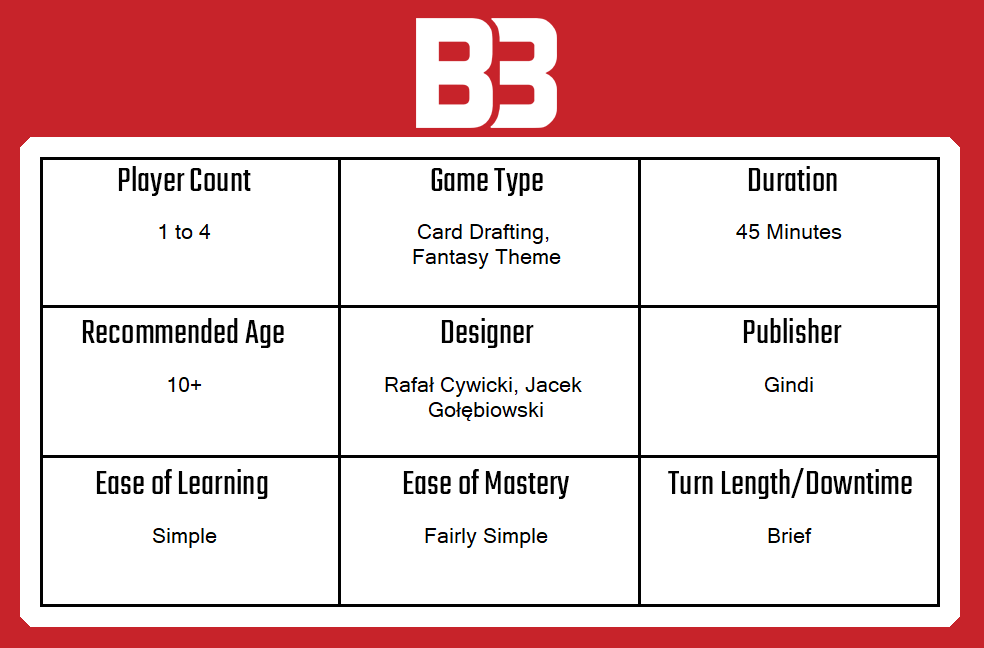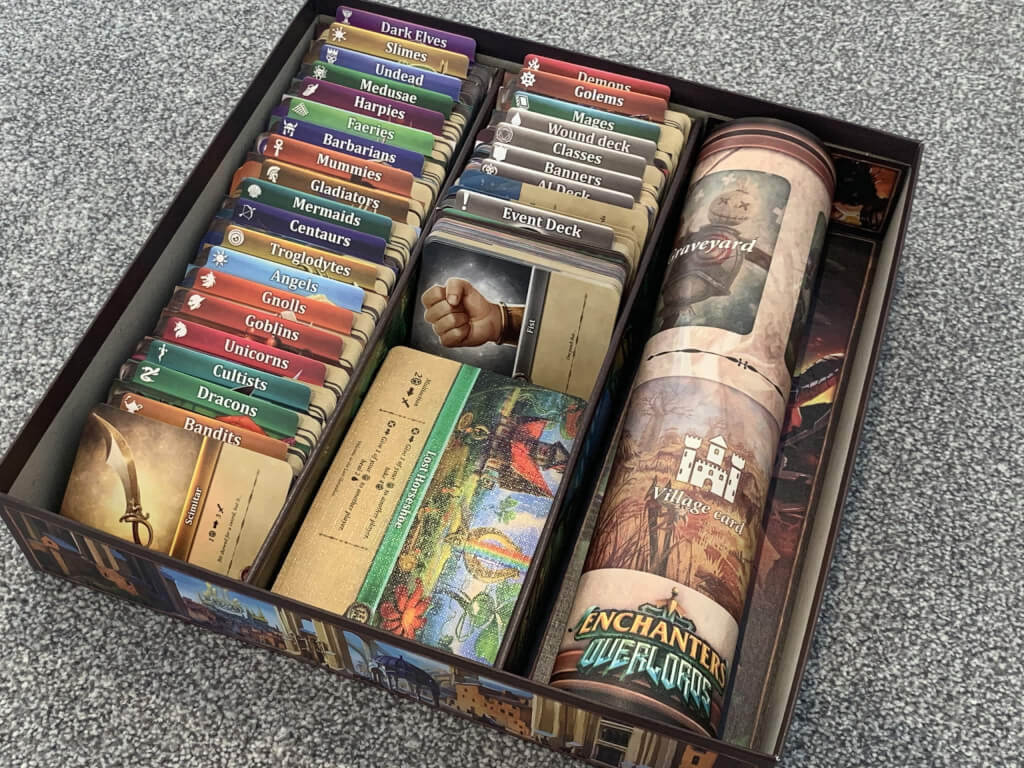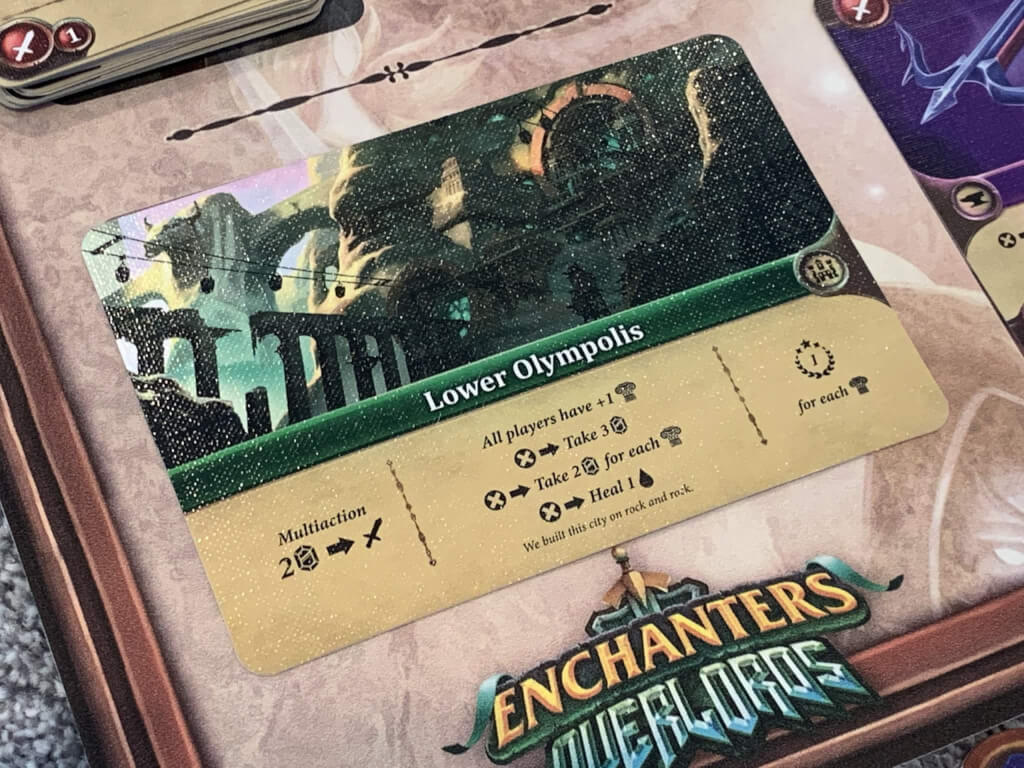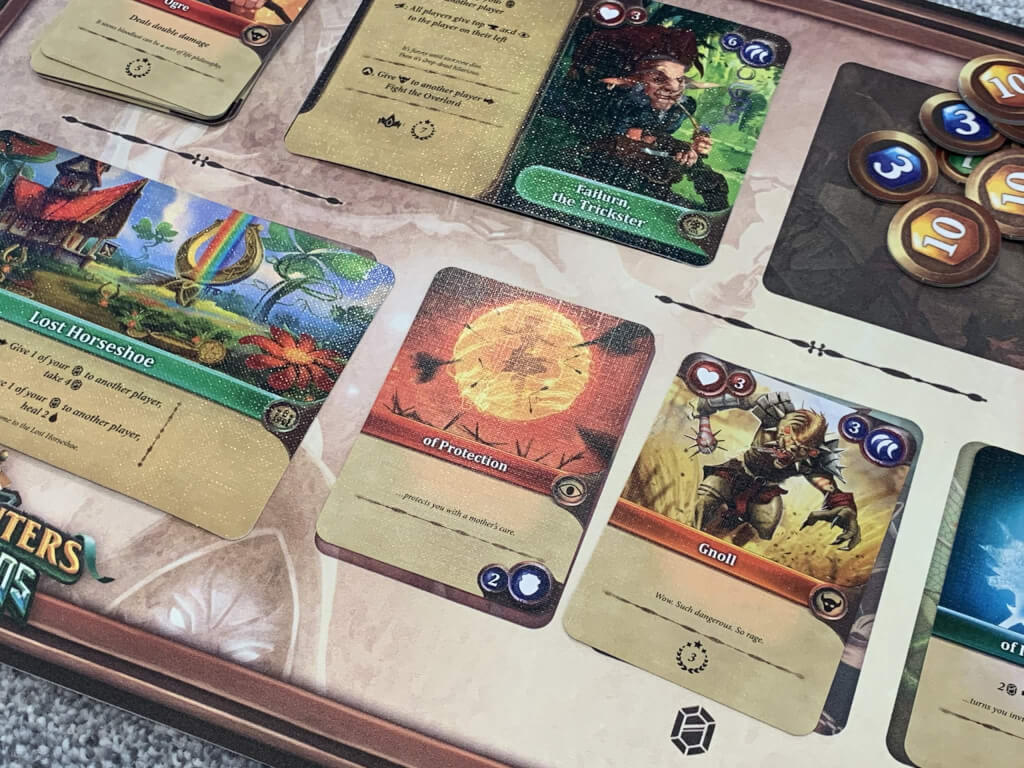Gindi’s Enchanters game is infinitely replayable thanks to Overlord and Odyssey content drop!

When it comes to choosing board games that fit Big Boss Battle and what I think our readers are interested in, I always look for bright, accessible games that have deep, competitive hooks to grab the players attention. Following a second Kickstarter campaign that introduced a ton of new content, Enchanters: Overlord and its Odyssey expansion seem to fit the bill perfectly.
Whilst Enchanters was originally released as a modest, small box game that featured just six decks of cards for a purely competitive experience, it has since been expanded upon time after time to deliver what fans have been asking for — more decks, cooperative and solo modes, and, crucially, more impetus.
The version of Enchanters that we were sent to review includes all of the content released to date, including the original game, the four additional expansion decks from the original Kickstarter, the whole Overlord expansion and the latest Odyssey expansion. This amounts to over 21 decks of enchanting cards, a ton of village and overlord cards, and full compatibility with the app-driven solo and cooperative modes.
Frankly, it’s hard to know where to begin when presented with so much content, and no matter what I do, I’ll never be able to experience every possible variation that the game provides, however, it seems logical to talk about the basic principles of what Enchanters is — aside from being a huge amount of stuff.

Stripping things back to their most basic, Enchanters is a tableau-building game in which each player (up to four) takes a basic weapon (their fist) and a basic enchantment (nothing, initially) and places them on their personal board. One deck per player (or about half of two decks per player in a two-player game) are then shuffled together to create a randomised combination of cards that will be used during the game.
Each deck has its own name and theme, and there are just over twenty in the complete box to choose from. Decks can be mixed in any way, so you can have angels, demons, faeries and gladiators participate, or unicorns, dark elves, mages and medusae — there’s no real limit. At two players, only cards from each deck marked with a “2” are used, whilst at three and four players, three or four full decks respectively are used.
There’s a tiny bit of deck loading to do to ensure that the first six, nine or twelve (depending on player count) cards are usable, but this is very straightforward. The deck is then placed to the right of the playing area. Six cards are then drawn from the deck and placed in a line from right to left in order to constitute what the game calls The Journey Track. To the left of this, an oversized village card will be chosen (either handpicked or at random) and place
And this is where things may get a little bit more complicated. Next, the players may choose to play with one of the overlord cards. If they do so, they just place it above the Journey Track and, like the village cards, overlords are oversized and easy to spot. The challenge comes from the fact that both village and overlord cards can be a little bit pernickety in that some work together, some really require specific decks to be in play and others are really designed for solo or co-op play (whilst others don’t really work with solo or co-op).
This does introduce a slight overhead for new players since there is such an overwhelming amount of content in the box, but I’m delighted to say that Gindi has included a quick start guide that indicates which decks new players should use, as well as a second guide that introduces players to the overlord concept. In most cases, whilst a particular village might work well with one or more specific decks, I haven’t yet found a situation where a choice of decks and villages result in a game-breaking situatio
Regardless of which mode you play in, and whether you do or don’t include an overlord, Enchanters plays out in a very similar way. On their turn, a player will choose from one of two actions — firstly, they can journey, or secondly, they may rest. When a player takes the journey action, they simply choose one of the six face-up cards and then add it to their tableau if it’s either an item or an enchantment. In this case, the number of gems shown below the card must also be paid, meaning that the more recently the item was added to the track, the more expensive it will be.
If it’s a monster, then instead of paying gems, the player will do battle, and to do so, they must have a number of attack symbols visible on their tableau to defeat the monster. Several game effects including those shown on the village or on the top cards in each of the item and enchantment stacks can be used to bolster the attack value, but it’s important to know that if the player can’t defeat the monster, then they must choose a different card for their journey action or rest.
When a card is taken, then if it’s a defeated monster it is simply added to that players pile, and any action shown on it is taken (for example, a defeated assassin will deal two wounds to any other player) and will be used to score glory points at the end of the game. If the card is an item or an enchantment card, it will be added to the top of the relevant stack in the player’s tableau.

Now bear in mind that a player only ever has two stacks — items and enchantments — so when a new card is taken, it will cover the previously visible card. Each card in a stack is slightly offset upwards so that the bottom of the card before it still shows. More often than not, this means that as the game goes on, the player will become more and more powerful, because the attack, defence and sometimes other bonuses from previously covered cards will be added to the values and effects on the visible card.
This process of upgrading items is really where the game takes its name, and the thematic suggestion that players are building an enchanted item really comes through in the way each turn unfolds. The more powerful the item, the more damage the player can either deal, or withstand before taking wounds. Whilst each monster does deal damage, few are as powerful as the overlord cards, which add their own individual flavour to each game depending on what their text suggests.
Resting is usually necessary to either clear wounds or to regain gems, and the available rest actions will be shown on the village card. Whilst removing wounds and gaining gems are the standard actions that you’ll almost always find, many villages have other rest effects that can be good or bad for the active player, or the other players, and like the wider gameplay, each village has its own theme that tends to be reflected in the effects that it provides. Some village effects are actually passive, affecting everything that happens during a game and further changing things up.
The other important thing to note about resting is that whenever a player takes this action, the leftmost card on the journey track will be discarded, and if an overlord is in play, this will trigger an invasion. Invasions vary wildly from one overlord to the next, and each overlord has different effects based on the card being discarded. Some may not react at all to an item being discarded, while another might become stronger.
This, again, is another way in which Enchanters differentiates itself because it is both extremely simple and very cleverly done. In the deck of probably twentysomething overlords, each one has a very different feel — some are straightforward, others are unpredictable and others begin weak and grow stronger or vice versa.
The cooperative game works the same way in terms of how the enchanted items are built and used against enemies, but now an app is introduced to drive some of the action and to dictate the consequences of certain aspects of the game. This, alongside the optional event cards, can further introduce randomness that the players need to prepare for by working as a team.
For example, you may sometimes wish to rest, but your partner needs the card that would exit the track if you do, but in taking something elsewhere on the journey track, you may make your own item weaker. When you compound this kind of decision with the possibility of an event that causes the overlord to unexpectedly attack, or the cost of all cards to be increased, then you have some real variance between the advanced cooperative game and the most basic competitive modes.
The more of Enchanters you play, the more of it you’ll understand and the more complex you will want to make the setup for each new game. The real strength of the game at this stage in its lifecycle is that it simply has an unplayable amount of content and a huge amount of modes and variants. Even over and above the solo, competitive and cooperative modes that I’ve mentioned (with or without overlords, events and other modules factored in) there are still long and short variants, harder and easier modes and so on to throw in.

I think Enchanters, therefore, ranks as one of the most versatile games in my collection. It has the near unique flexibility to be picked up and understood within five minutes by a novice or to challenge a hardened group of regular gamers. What I mean by that is, you can just take four decks and a few tokens to set up the most basic game and be playing in minutes, or you can choose the most advanced decks, the hardest mode and the toughest variant options and really test the mettle of those around the table.
That kind of flexibility is quite rare, and when you combine it with the visual appeal of the game, the extremely high build quality and the superb artwork, you really start to have an appealing product. Enchanters is a keeper for me, and it’s a game that I think I will keep returning to with players of all experience levels, and that’s something I don’t say very often about a new game these days, thanks to the amount of specialisation that the current market demands.
You can find out more about Enchanters, Enchanters: Overlords and Enchanters: Odyssey on the game’s website. and you can buy versions of it through the late pledge on Kickstarter.
Love board games? Check out our list of the top board games we’ve reviewed.


Comments are closed.